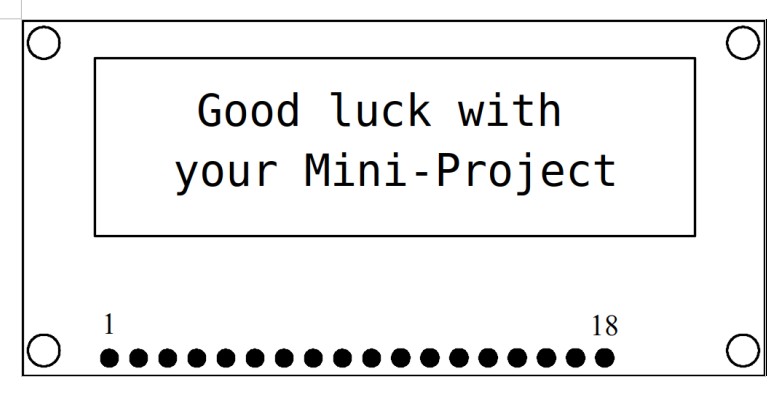Mini Projects
Introduction
The Mini Project builds on the experience gained in the microcontroller experiments (Microcontroller Programming Laboratory) that occupy the first part of the course. It gives you an opportunity to use your knowledge to build an open-ended project for a specific, practical purpose. At the heart of the mini project is still the Arduino Nano microcontroller, but additional parts will be made available. You will work in groups of four on your mini project, and you will return a single report on what you have achieved.
Alphanumeric Display module
The first step in the Mini Project is to complete Experiment 5: LCD Display Panel, as the alphanumeric display module will be central to the project, in order to display information from sensors, for example temperature readings.
Demonstration Program
The demonstration program introduced in Experiment 5: LCD Display Panel contains examples of how to display ASCII text, such as “Hello World”, and how to represent inputs from digital sources, such as the push buttons. Most importantly, it shows how to display variables such as time and analogue inputs.
Assessment of the Mini-Project
The mini projects will be allocated near the end of the laboratory exercises. Each team will be given a task to perform, which will require that some additional hardware be connected to the Arduino on the plug-in breadboard. Near the end of term, the mini-projects will be assessed by staff members at the laboratory bench. This part of the assessment carries 10 marks.
For example, suppose a mini-project team has decided to build a digital voltmeter. If the finished item does not work a mark of less than 40% of the maximum will be awarded. If the voltmeter works but the number displayed is not calibrated, then a mark of 40-50% will be awarded. If the voltmeter works and has additional functionality, e.g. averaging and correct calibration, this will receive a mark of 50-70%. Marks greater than 70% will require some really clever additional features, such as bipolar input voltage, offset zero, memory and so on.
In addition to the one-to-one assessment of the mini-project, each team will submit a report worth a further 20 marks which should contain the following:
Names of team members.
Title of Project.
Introduction; the task set, and how it was approached.
Technical details such as additional circuits and input-output pin assignment.
A flow chart of the program.
A conclusion, in which the team members can reflect on how the project could be improved, possible alternatives and so on.
The format of the report is left open and up to you: a formal document, PowerPoint presentation, poster, video, podcast etc, would all be acceptable providing that the assessment points are covered.
Possible titles for the mini projects
For possible projects titles, see the following pages.

Dr. Chris Jobling and the EG-151 team, November 2024
Copyright © 2021-2024 Swansea University. All rights reserved.